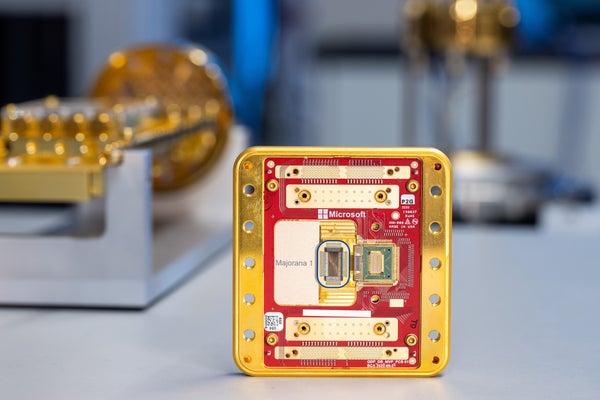
Microsoft Claims Quantum-Computing Breakthroughbut Some Physicists Are Skeptical
www.scientificamerican.com
February 20, 20253 min readMicrosoft Claims Quantum-Computing Breakthroughbut Some Physicists Are SkepticalWith its topological quantum computers, Microsoft aims to reach useful scales faster than competing technologiesBy Davide Castelvecchi & Nature magazine Microsoft has unveiled its Majorana 1 quantum chip. John Brecher for MicrosoftMicrosoft has announced that it has created the first topological qubits a way of storing quantum information that the firm hopes will underpin a new generation of quantum computers. Machines based on topology are expected to be easier to build at scale than competing technologies, because they should better protect the information from noise. But some researchers are sceptical of the companys claims.The announcement came in a 19 February press release containing few technical details but Microsoft says it has disclosed some of its data to selected specialists in a meeting at its research centre in Santa Barbara, California. Would I bet my life that theyre seeing what they think theyre seeing? No, but it looks pretty good, says Steven Simon, a theoretical physicist at the University of Oxford, UK, who was briefed on the results.At the same time, the company published intermediate results but not the proof of the existence of topological qubits on 19 February in Nature.On supporting science journalismIf you're enjoying this article, consider supporting our award-winning journalism by subscribing. By purchasing a subscription you are helping to ensure the future of impactful stories about the discoveries and ideas shaping our world today.Superconducting wireTopological states are collective states of the electrons in a material that are resistant to noise, much like how two links in a chain can be shifted or rotated around each other while remaining connected.The Nature paper describes experiments on a superconducting nanowire device made of indium arsenide. The ultimate goal is to host two topological states called Majorana quasiparticles, one at each end of the device. Because electrons in a superconductor are paired, an extra, unpaired electron will be introduced, forming an excited state. This electron exists in a delocalized state, which is shared between the two Majorana quasiparticles.The paper reports measurements suggesting that the nanowire does indeed harbour an extra electron. These tests do not, by themselves guarantee that the nanowire hosts two Majorana quasiparticles, the authors warn.According to the press release, the team has carried out follow-up experiments in which they paired two nanowires and put them in a superposition of two states one with the extra electron in the first nanowire, and the other with the electron in the second nanowire. Weve built a qubit and shown that you can not only measure parity in two parallel wires, but a measurement that bridges the two wires, says Microsoft researcher Chetan Nayak.Theres no slam dunk to know immediately from the experiment that the qubits are made of topological states, says Simon. (A claim of having created Majorana states, made by a Microsoft-funded team based in Delft, the Netherlands, was retracted in 2021.) The ultimate proof will come if the devices perform as expected once they are scaled up, he adds.Early announcementSome researchers are critical of the companys choice to publicly announce the creation of a qubit without releasing detailed evidence. If you have some new results not connected to this paper, why dont you wait until you have enough material for a separate publication?" says Daniel Loss, a physicist at the University of Basel, Switzerland. Without seeing the extra data from the qubit operation, there is not much one can comment, says Georgios Katsaros, a physicist at the Institute of Science and Technology Austria in Klosterneuburg.We are committed to open publication of our research results in a timely manner while also protecting the companys IP [intellectual property], says Nayak.Microsoft has also shared a roadmap for scaling up its topological machines and demonstrating that they can perform quantum calculations2. Vincent Mourik, a physicist at the Helmholtz Research Centre in Jlich, Germany, whose concerns helped to lead to the earlier retraction, is sceptical of the whole concept. At a fundamental level, the approach of building a quantum computer based on topological Majorana qubits as it is pursed by Microsoft is not going to work.As we perform more types of measurements, it will become harder to explain our results with non-topological models, says Nayak. There may not be one single moment when everyone will be convinced. But non-topological explanations will require more and more fine-tuning.This article is reproduced with permission and was first published on February 19, 2025.
0 Comentários
·0 Compartilhamentos
·38 Visualizações


